1958 Aston Martin DB4 Coupe Superleggera 3.7
As the first Aston Martin to be designed by Touring and the first road car to use the company’s new straight-six engine, the DB4 laid the foundations for its later, more famous models. For the car’s 65th anniversary, we look at its history before driving a beautiful, early model.
WORDS & PHOTOGRAPHY PAUL WALTON
DB4 3.7
Profile of the DB4 that made its debut 65 years ago, explaining how with its Superleggera body by Touring and Tadek Marek-designed engine, the car set the standard for Aston’s later models.
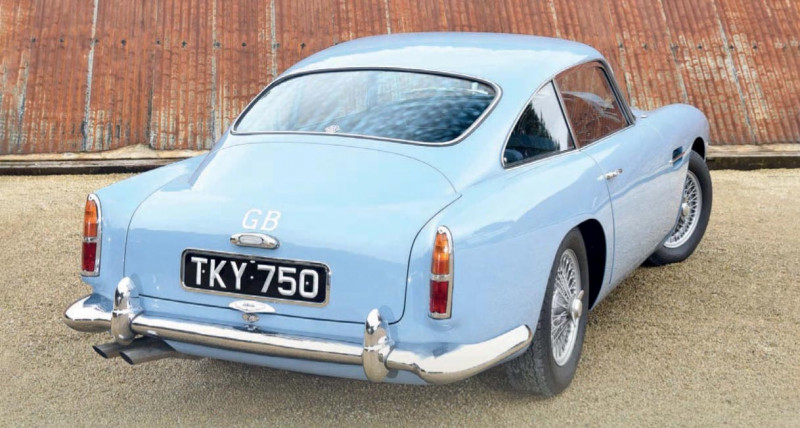
Being the first of something isn’t a guarantee that you’ll be remembered. Take Frenchman, Louis Blériot, for example. He might have been the first to fly across the English Channel on 25 July 1909, yet compared to the more famous Charles Lindberg who crossed the Atlantic 18 years later, he’s a mere footnote in aviation history.
Or Martin Cooper, a former Motorola employee, who on 3 April 1973 was the first person to make a call using a mobile phone. Hardly a well-known name today, he was no doubt also the first to get a sales call on one as well.

And then there’s the DB4. Although it was the first Aston Martin to be designed by Touring using its Superleggera style of construction, plus the first road car to be powered by the company’s new straight-six, the car has always been overshadowed by its more famous replacement.
Yet it deserves more than that. As a handsome and fast model in its own right, the DB4 propelled Aston from a manufacturer of simple sports cars into one more known for its glamorous GTs.
To mark the car’s 65th anniversary, we’re looking at the DB4’s history before driving a beautiful, early example. Debuting in 1950, the DB2 had firmly established Aston Martin in the British post-war car industry. But by the middle of the decade and even after a 1953 facelift that resulted in the DB2/4, in terms of its performance and interior space, the car was starting to feel oldfashioned.
So, in 1954, Aston’s chief engineer, Harold Beach, began work on a replacement that was internally known as Project 114 due to its number on the company’s project register. Beach initially designed a new perimeter type of frame for the car and it used a development of the same double wishbone front suspension as the DB3S and DBR1 racing cars. Plus, for the first time in Aston Martin’s history, at the rear was a De Dion rear axle.

By the end of the year, an unbodied prototype powered by Aston Martin’s current 2.9-litre straight-six engine was already being tested. The car was later fitted with a four-seat body designed by Aston’s then designer, Frank Feeley, and used by the company’s chairman, David Brown, as his personal transport.
Looking like a bloated Alvis, Brown later suggested the Turin-based carrozzeria Touring, should design the car instead. The link between the two comes from around the same time when three DB2/4 chassis were sent to Touring to each have a pretty barchetta-like roadster body fitted.
Touring, though, wouldn’t develop a new car on Beach’s chassis; it would only do so using its own Superleggera style of construction that consisted of a framework of small-diameter steel tubes that are covered by thin alloy body panels. After patenting Superleggera in 1936, Touring had used it on and off since 1938, mainly for special-bodied Alfa Romeos.
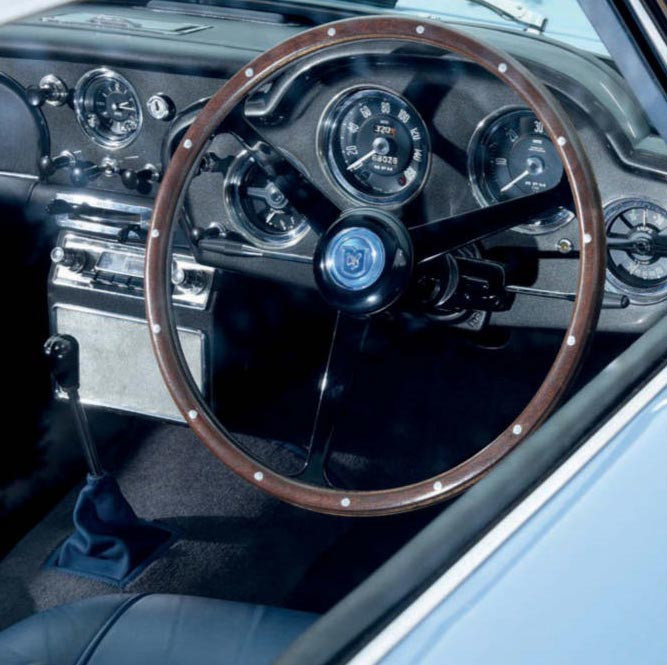
“I was sent to Milan to liaise with them [Touring] over the type of body structure they proposed, although the front and rear suspension of Project 114 was retained with more up to date ideas,” said Beach in Geoff Courtney’s 1978 book, The Power Behind Aston Martin. “I was going to and fro between England and Italy as I had to work with Touring quite a bit. They were a fantastic crowd.”
What Touring had designed was a clean-lined, well-proportioned fastback style of coupe that despite its Italian parentage was every inch the Aston Martin. And although at 4.5m long and 1.7m wide it was a relatively large car due to the Superleggera construction, but the finished model weighed a mere 1,392kg (3,070lb), a whopping 71kg (156lb) lighter than a Jaguar XK150 3.4-litre fixed-head coupe.

“When you think of it, it was a major exercise to turn my proposed perimeter frame – which regarded the chassis as separate from the body – into Touring’s idea of a platform frame, which viewed the chassis and body almost as one and far more integrated,” continued Beach. “I really accepted this idea of regarding them as one rather than as separate entities because of the tremendous weight-saving and improved stiffness.”
Power would be courtesy of a new 3.7-litre straight-six that had been designed by Aston’s Polish engine designer, Tadek Marek. “He and I worked very closely together,” said Beach about the designer in The Power Behind Aston Martin, “and I found him to be a clever chap.” Although initially used for the DBR2 racer in 1956, the DB4 would be the first road car that used the engine.
Coming with twin SU HD8 carburettors, the engine produced 240bhp at 5,500rpm, sufficient for a dash to 60mph in a little under nine seconds and a maximum speed of 140mph. These were considerably better figures than the final iteration of the DB2, the DB Mk III with its 2.9-litre engine that arrived in 1957, and it put Aston Martin into another league of car manufacturers. The transmission was a four-speed manual gearbox made by the gearbox division of the David Brown Corporation.
By July 1957, the first DB4 prototype to feature Touring’s body and chassis, Beach’s suspension plus Tadek’s engine was ready for the road. “I was immensely thrilled with it,” continued Beach in Courtney’s book, “especially when you remember it was the first car completely designed by the company under David Brown.”
Someone else who was overjoyed by the new car was Aston’s chairman who personally tested the prototype around his home in the Chilterns. “That car went really well and David Brown was thrilled,” explained Beach further. “It was fantastic, in a completely different world from the handling and roadholding points of view in particular. When David Brown had finished, he said to me, ‘This is a very promising motor car.’”
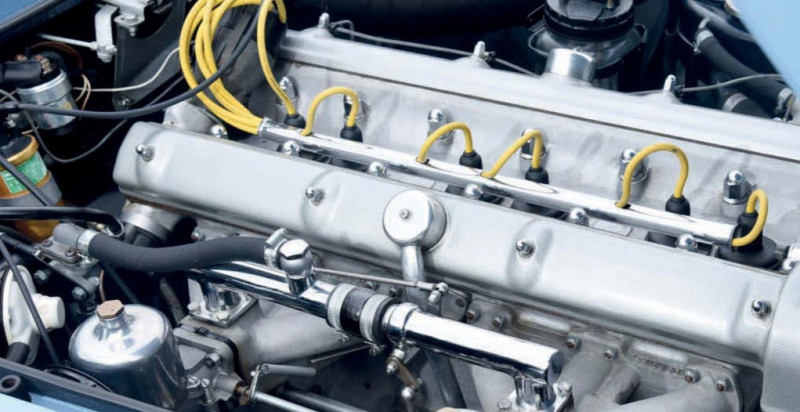
One aspect of the car’s mechanical design that changed before it reached production was the rear suspension.
The De Dion axle that Beach had wanted from the outset was found to be too noisy when joined to the David Brown gearbox and the Huddersfield-based engineering company couldn’t find a solution. It was therefore replaced by a standard set-up of trailing arms and a Watts linkage. With its good looks and powerful engine, the press reports were understandably positive when the new model, now officially known as the DB4, made its debut at the 1958 British Motor Show in October. “This new and exciting car, which is certainly in the top grade of Gran Turismo cars,” said Autocar in its October 3 1958 issue, “should prove to have a performance equal to most of the exotic continental cars in this category and, of equal importance, it will be marketed at a price competitive with them.” Indeed, at £2,650 in 1958 it was considerably cheaper than the BMW 507 and Maserati 3500GT. Perhaps due to its development taking a mere four years, in 1960 and after 149 standard cars had been produced, the DB4 received some minor updates. These included opening rear quarter lights made from flat rather than curved glass plus a front-hinged bonnet. Larger front brake calipers were also added, the sump was enlarged from 14 to 17 pints and the oil pump was uprated. Although Aston never gave this or any of the three further updates an official designation, today it’s known as the Series 2.
As the 52nd example produced, the Wedgewood Blue car seen here is a very early example of the Series 2. First registered on 20 May 1960, the car spent its early life in the north of England. After being with the same owner between 1965 and 2006, the still unrestored car was sold with just 57k miles on the clock before being sold again six years later. Over the next three years it was the recipient of a full nut-and-bolt restoration, its now immaculate condition making it a perfect representation of an early DB4.
The profiles might be almost identical, but the DB4 has a very different character from that of the more familiar DB5. With circular headlamps, a simple aluminium mesh grille in the familiar shape of the radiator opening and the same tall rear lights as the DB Mk III that originated from the Humber Hawk and that were also used on the Alvis TD21, it appears more old-fashioned than its racier replacement. Yet it’s still a handsome car, Touring’s delicate lines are perfectly proportioned while the large, 16in wire wheels give it a sporty, almost muscular presence.
Although the DB4 was entirely built at Aston’s Newport Pagnell factory, the pair of Superleggera badges along the edge of the bonnet are due to Touring granting Aston Martin a licence to build the car using its lightweight system. The Italian wording and the mystique surrounding it makes the already stylish car feel more so.
The shape and layout of the well-equipped dial binnacle located directly in front of the driver is largely similar to that of the DB Mk III and is dominated by the large speedo and rev-counter. Covered in more chrome than a Wurlitzer jukebox, it too makes the car look older than it is. Thrumming into life the moment I twist the key in the ignition, the 3.7-litre engine soon settles down to a lively sounding grumble. After carefully negotiating the remote Cotswold roads that surround The Classic Motor Hub where the car is currently for sale, I eventually reach a long straight. With the road ahead of me empty, I nail the throttle hard, the straight-six responding instantly as I do so, causing the big car to accelerate with a keenness that takes me genuinely by surprise. As the speed grows the cabin is soon filled by the distinctive deep growl of the Tadek-designed six.
David Brown’s four-speed transmission is surprisingly fast and accurate considering its age, the speed of its changes further aiding the car’s swiftness. With its sharp, nicely weighted steering and perfectly set up suspension that allows the car to remain composed through corners, it makes the DB4 a genuine sports car in the same mould as the Jaguar E-type or Triumph TR4. Yet thanks to the supple ride and spacious, comfortable interior, it could also be argued the Aston Martin was the UK’s first genuine high performance long distance grand tourer.
“To drive the DB4 really fast still leaves one moderately relaxed,” said Motor magazine in its 23 November 1960 issue. “Consequently, a long journey made without trying results in quite absurdly high averages and relatively little fatigue.” Six decades later and no doubt the same could still be said of the car.
Over the next three years, until production finished in June 1963, the DB4 was given three more largely minor updates. The Series 3 from April 1961 introduced rear demister vents and an electronic tachometer while the tall rear light clusters of the Series 1 and 2 were swapped for three separate circular lenses for the indicator, rear/brake light and red reflector, each set on a heavy chrome base. Just six months later, Aston released the Series 4 that featured a new radiator grille that had horizontal and vertical bars plus a lower bonnet air scoop.
At the same time, Aston Martin introduced two new DB4 variants, including a stylish convertible, and a higher performance Vantage model.
The latter was recognisable by having the same style of faired-in headlights as the GT. With three SU carbs, a revised cylinder head, bigger valves and a higher compression ratio, power was increased by ten percent over standard to 266bhp.
For the fifth and final series that arrived in September 1962, the rear reflectors had been relocated to the bumper due to the addition of reversing lamps while the front indicator lenses had also been enlarged. More importantly, the Vantage was lengthened by 9cm to increase rear legroom while the roof was raised slightly.
Together, these changes laid the foundations for arguably Aston’s most famous model, the DB5, that physically differed little from the Series 5 Vantage. It’s this similarity together with its many Bond appearances that has resulted in the car forever overshadowing its predecessor. So, while the DB5 has become part of British culture, appearing on everything from postage stamps to book covers, the DB4 is barely recognised. Even its one moment of glory, Michael Caine’s grey convertible in the 1969 film, The Italian Job, is ruined when the car is apparently shoved off a mountain by a huge digger. We’re just as bad. While the DB4 gets this single feature to mark its 65th anniversary, the next issue of AMD will be almost entirely dedicated to the DB5 turning 60.
Yet despite its lack of media presence, unlike Blériot and Cooper in the history of aviation and communication, the DB4 is clearly more than just a footnote in Aston Martin’s past. In terms of its looks, comfort, and performance, by being the first in many ways, the car set the standard for all of the future models that continue to this day.
Thanks to: The Classic Motor Hub (classicmotorhub.com 01242 384092)
The GT was a lighter and faster version of the DB4, aimed primarily at racing In September 1959 Aston introduced a competition version of the DB4 that was aimed at gentlemen racers. Not only was it lighter and shorter than the standard car, but thanks to three Weber carburettors and a raised compression ratio resulting in 300bhp, it was faster too. The GT was the first Aston to feature faired-in headlamps with domed covers, a design it would continue with until 1970 when production of the DB6 Mk2 came to an end. At the hands of some of the best drivers of the day, the GT variant was incredibly fast and therefore very successful. “All closed road-going Astons seemed muscular and strong and a little agricultural,” said Stirling Moss in his 1987 biography, My Cars, My Career, “but the DB4 GT was also quite well balanced, it had bags of power and when I drove against the Jaguar saloons it was no contest.”
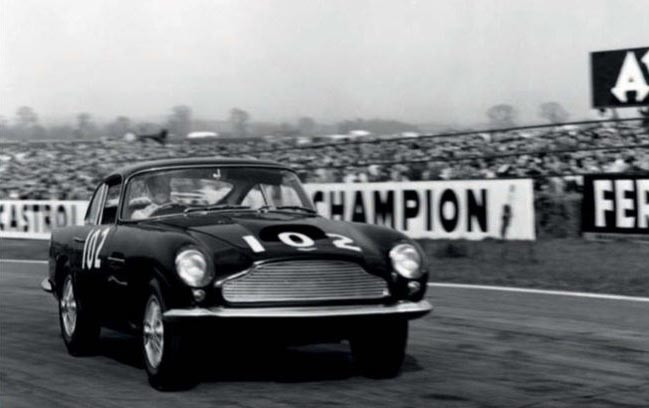
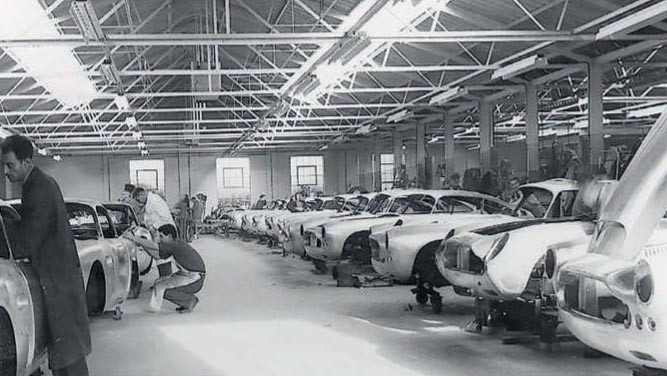
Just 75 GTs were produced in four years plus another 19 that were fitted with an even lighter bodyshell by Italian coachbuilder, Zagato.
The DB4 was the first Aston Martin to have its full production at Newport Pagnell
LIGHT SWITCH Stirling Moss on his way to winning Goodwood’s Fordwater Trophy in a DB4 GT in April 1960


